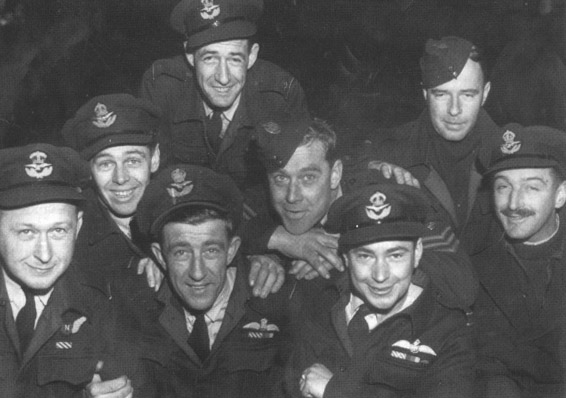 The crew assembled for the marathon flight. L to R: Wilfred Gordon, George Young, Francis Smith, Clive Tindale, Harry Tickle, Eddie Hudson, Keith Ower and Tom McCarthy (Keith Ower).
The crew assembled for the marathon flight. L to R: Wilfred Gordon, George Young, Francis Smith, Clive Tindale, Harry Tickle, Eddie Hudson, Keith Ower and Tom McCarthy (Keith Ower).It was decided to replace the engines of "G" for George when it was donated to the Australian government, as the original engines were considered to be worn out. After being selected as the pilot, Flt/Lt Hudson expressed dissatisfaction with the replacement engines and they were therefore replaced with four new engines for the flight to Australia.
 The crew assembled for the marathon flight. L to R: Wilfred Gordon, George Young, Francis Smith, Clive Tindale, Harry Tickle, Eddie Hudson, Keith Ower and Tom McCarthy (Keith Ower).
The crew assembled for the marathon flight. L to R: Wilfred Gordon, George Young, Francis Smith, Clive Tindale, Harry Tickle, Eddie Hudson, Keith Ower and Tom McCarthy (Keith Ower).H.R.H. The Duke of Glouchester, the Governor General Designate of Australia, who had very recently visited 460 Squadron on 20th July 1944 at Binbrook sent a good–will message wishing the crew a safe voyage and hoping that he would renew the acquaintance with George in Austalia.
The crew:
Captain, Flt. Lt. E.A. Hudson, D.F.C. & Bar of Rockhampton
Second Pilot, Flg. Off. E.P. Smith, D.F.C., of Newcastle
Navigator, Flg. Off. W.C. Gordon, D.F.C., of Raleigh
Bomb Aimer, Flg. Off. T.V. McCarthy, D.F.C. & Bar, of Brisbane
W. Op./Air Gunner, Flg. Off. G.H. Tindale, D.F.M., of Cremorne
W. Op./Air Gunner, Flg. Off Young, D.F.M., of Matraville
Fitter, Flt. Sgt. H. Tickle, of Adelaide
Fitter, Sgt. K.A. Ower, of Telamon
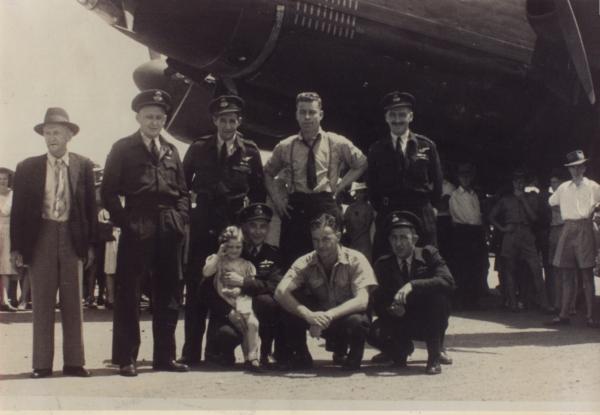 Left to Right: Mr Hudson (father of Eddie), Harry Tickle (with hands on hips), Eddie Hudson (in front) with his 3–year–old neice, Patricia Johnson.
Left to Right: Mr Hudson (father of Eddie), Harry Tickle (with hands on hips), Eddie Hudson (in front) with his 3–year–old neice, Patricia Johnson.His is greeted by his father and his 3–year–old neice, Patricia Johnson, who later became Mrs. Weekes.
On arrival in Australia on the 10th of November 1944, Flt/Lt Eddie Hudson requested that he be allowed to fly the Lancaster to Rockhampton on the 12th of November 1944 to see his father and family. Taking off on the morning of the 12th, after circling Brisbane, George was flown to Rockhampton, where after circling the town twice, they landed at 3pm. The aircraft's captain climbed out, and cheered by the crowd, was greeted by his father and family from whom he had been parted for over 4 years. George was put on show, whilst the crew members were feted all over the district. In April 1945 G–George once again visited Rockhampton, in company with Beaufort A9–580 in connection with the Third Victory Loan.
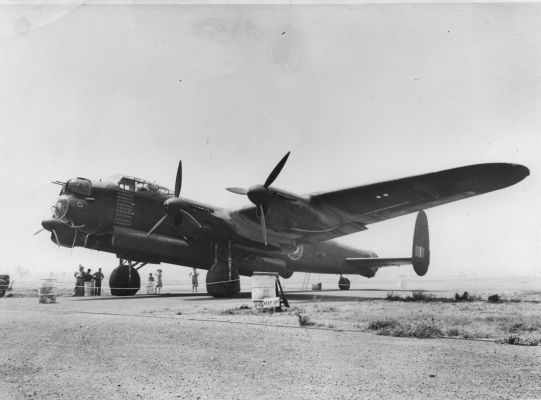 "G" George standing at Archerfield ready to fly the people who have bought the "Will to Win" War bonds early 1945.
"G" George standing at Archerfield ready to fly the people who have bought the "Will to Win" War bonds early 1945.Soon after this photo was taken a young 9 year old lad was standing looking longingly up at the pilot. Many years later he still remembered looking up at this great plane, so big, he hadn't seen any plane nearly so big. Eddie Hudson carrying out his cockpit inspection looked out and seeing the lad, and seeing the expression on his face, called out, "What are you doing down there young fellow" to which the lad replied, "I'm waiting to fly the Lancaster bomber."
After the passengers who had bought their War bonds were loaded and "G" George airborne, the young lad being mad keen on aeroplanes sneaked his way to the cockpit. The pilot seeing him, invited him to: "Hop up here laddie" and set him on his lap. With a quick instruction to put his hands on the wheel of the control column, and when this was done, "Now young man, turn the wheel this way", the lad was amazed to see the plane heal over and looking out past the massive engines he could see the ground, and then a view of the railway tracks. The smoke from the black locomotive was spreading underneath him. "Now turn the wheel over this other way", and suddenly this big plane had tipped over the other way, and the lad was looking past the other two engines down at the ground on the other side.
With a little more confidence he did a bit more wheel turning one way and then the other.
This was the introduction to flying for young Barry Usinski, the son of Alexander Usinski, who with his brother Peter Usinski were joint owners of A & P Engineering. They were engaged in machining and assembling the undercarriage members for the Mosquito bombers being assembled in Australia.
They were also conditioning generators and rewiring where necessary from the American submarines being serviced in Brisbane. This necessitated cutting a hole in the hull of the submarine to get the generators out, then when they were finished working on them and replacing them in their position, welding up the hull. Young Barry later joined the cadets and learned to fly. Presently working in the London area Barry is engaged in a team who are studying the warming effects on England of the Gulf Stream, and what action may be taken if the stream altered its course leaving England to freeze up, with ice bergs near the coasts, similar to New Foundland.
As often as he can Barry puts in as much time flying Tiger Moths and other more powerful planes as he possibly can. On a recent business visit to Brisbane he has been involved as a consultant in the project of building four/fifth scale models of Spitfires being used as a cheaper version for pilots converting to fly spitfires, and also suitable for leasing to film companies for filming of World War 2 aerial battles, and any other suitable advertising.
Barry was very surprised to find he was most certainly the youngest person ever to fly a Lancaster namely "G" George.
In the meantime we are searching for a photo of Barry beside the beloved Tiger Moth.
(authors Michael Nelmes & Ian Jenkins)
The Minister for Veterans Affairs, Bruce Scott, praised the authors during the launch of this book, detailing the life story of this famous plane. The Australian newspaper, reporting the launch of the book, featured Mick McGrory DFM (bomb aimer, Saint–Smith crew) and Don Cruden DFC (navigator, Morgan crew). Two other G–George crewman, Bill Mitchell DFC DFM (W/OP, W/Cdr Martin crew) and John Moore DFC DFM (Wales crew), were also present. Other George–related people included the niece of pilot on the UK–Australia flight, Mrs Weekes (3 yr. old neice of Fl/Lt Eddie Hudson, in the picture of G–George at Rockhampton in Nov. 1944), and around 130 guests including many Bomber Command men.
AWM film footage of George leaving Scotland and arriving at Amberley in 1944 was shown on a plasma screen.
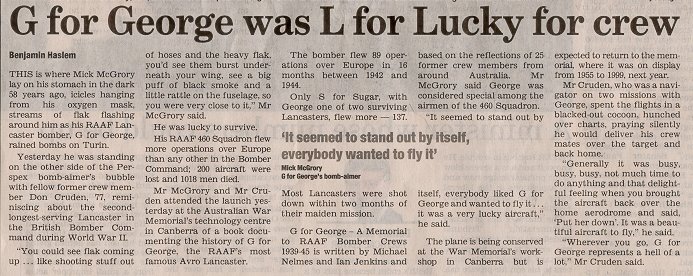
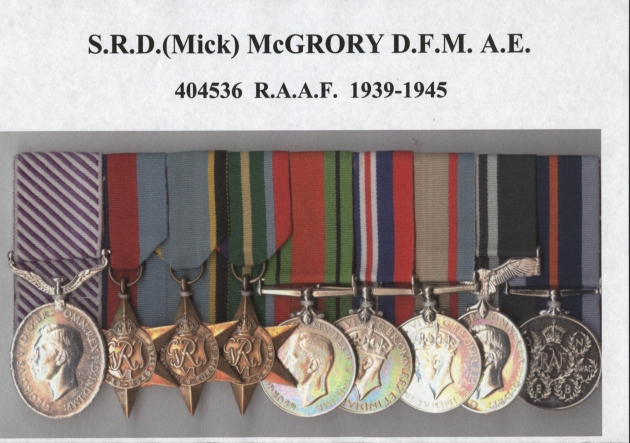 S.R.D. (Mick) McGrory, DFM, AE
S.R.D. (Mick) McGrory, DFM, AE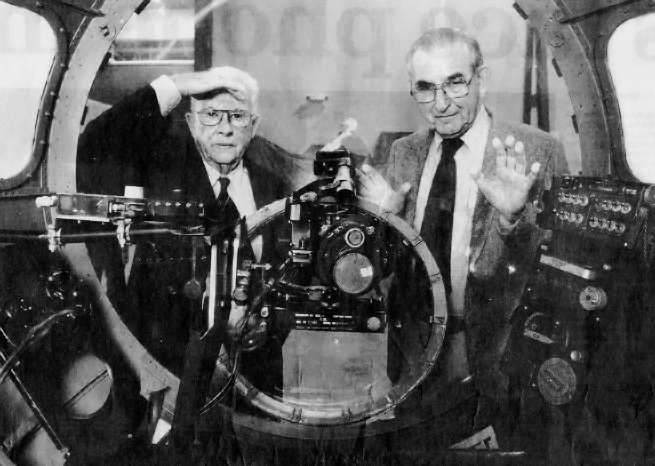 There we were: Mick McGrory, left, and Don Cruden peer through the bomb-aimer's bubble in the Lancaster being restored in Canberra. Picture: Ray Strange.
There we were: Mick McGrory, left, and Don Cruden peer through the bomb-aimer's bubble in the Lancaster being restored in Canberra. Picture: Ray Strange.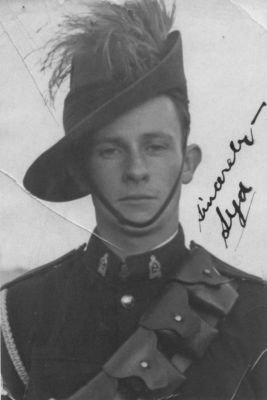
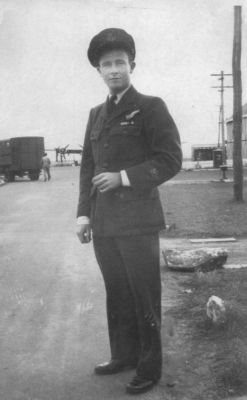
Sydney McGrory first joined the Light Horse. Seeking more action he volunteered for Royal Australian Air Force Air Crew and following training as a bomb aimer went on to bomber command.
Bomb Aimer, Flight Sergeant "Mick Mc Grory" after completing his tour with 12 (RAF) squadron and 460 (RAAF) squadron, Bomber Command, was posted as a bombing instructor to 1662 Heavy Conversion Unit, Blyton. Then on to No.1 Air Armament School, Manly to complete an Air Bombing Instructors Course, which he passed class A. No record of this has ever appeared in RAAF records.
He was then chosen by Air Ministry to join what they called "The Line Shooter's Club." This consisted of a group of veterans, mainly from Bomber Command, attached to the Ministry of Aircraft Production, who toured factories making aircraft components to give "pep talks" to factory workers to boost and maintain morale. Sir Frederich Page, T.O.M. Sopwith and other notables, were honorary members. Following this he was posted back to Australia, arriving in June 1944. They were greeted with hostility and denied access to the Sergeants' Messes at Bradfield Park and Townsville. Mr McGrory complained that the RAAF had no counselling.
Supplement to THE ARGUS
"G" for George Signs Off
Personal Story of a War–worn Lancaster That Has Explored Australia By a Special Correspondent
THIS IS THE STORY of the famous British Lancaster bomber G for George, veteran of 90 operational flights over enemy territory. and who (please note the personal pronoun, for George – as his crews will tell you – is very much a person) has been touring Australia to persuade people to buy more bonds in the Third Victory War Loan.
Many records have been kept of G for George's career. There is one in the archives of the Air Ministry – very official – and one – very personal – in the pocket–book of Flight–Sgt Tickle, mechanical nurse of the bomber since it was commissioned in 1942. Between these there is a veritable library of log–books giving G. George's life story, but who is more suited to tell it than G. George himself?
This is the story of G for George, told as only an old bomber can tell it – cryptic phrases drawing shadow pictures of night raids over Germany, of the sky ablaze with tearing flak, of the swift menace of fighters, of destruction and the loneliness of death.
Yet through it the camaraderie of the air, the dogged determination of crews working in perfect unison, their lives the spirit of youth with its frivolity in the face of death and its willingness to sacrifice life so that the British Empire may live in freedom, honour, and security.
DIARY OF "G" GEORGE
SEPTEMBER 5, 1944: An aerodrome in England.
I have a new name. Of course, I am still G for George – I'll always be that to the boys – but officially I am called A66–2. This is because I am now an Australian citizen, and we are due to leave England for the Antipodes next week.
I came into being two and a half years ago. Production of the thousands of parts which go into the construction of a bomber as big and complicated as I am had been going on all over the country for many months. Then they had to be despatched to the assembly plant – wings from here, petrol tanks from there, nuts and bolts from a garage geared for manufacturing, hydraulic systems from a plant specialising in their intricacies, tyres from a rubber factory, crystalline perspex from a glassmaker's – they all come rolling in by road and rail, and sometimes even floating down the canal waterways through the English countryside. Then at this great parent factory each part is fitted or riveted into its appropriate place. So at last a bomber is born.
I was known as W4783, and under that name I left my dispersal point home, nicely shaded and hidden by trees on the big Midlands factory aerodrome, to be flown off to join my squadron. I was ferried half across England by an Air Transport Auxiliary pilot who had only flown one Lancaster before, but he treated me gently and efficiently, so I responded, behaving myself admirably.
I say "my" squadron because I have been with it for so long now that I take a proprietary interest. It is the famous No. 460 Squadron, commanded by Group–Captain Hughie Edwards, VC, DSO, DFC, who is another Australian.
But turn back the pages and read for yourself of the events which led to my being chosen to go to Australia.
OCTOBER 22, 1942: Today I arrive at X aerodrome to join my squadron. I use the mystic symbol so that in the unlikely event of my being shot down over enemy territory I shall not disclose secret information.
X is a fine base from which to operate, the runaways are broad and smooth and of ample length. With a heavy bomb load up it is good to have plenty of room for an easy take–off. I am satisfied with my new home, also with my new masters. My pilot, Flight–Sgt Saint–Smith, and all his crew are Australians, and seem a wizard crowd. He and my personal attendant, Flight–Sgt Harry Tickle, were down at dispersal this afternoon giving me the once over.
Tomorrow work starts in earnest to train me up to fighting trim for our first ops trip. The squadron has converted from Manchesters, so we Lancs have a fine record to live up to – but we'll show the Jerry how to lay eggs.
DECEMBER 6, 1942: Back from first operational flight. We bombed Mannheim. Flight–Sgt Saint–Smith painted a little figure with a halo on his head on my fuselage also my first bomb showing one ops trip. There will be many more. Harry Tickle said I did "o'right for a new chum."
MARCH 14, 1943: Nothing of interest to report. The usual missions, bags of flak, but we were spot on the target, and the result was better than Guy Fawkes night. I miss the "Saint" now that he has left the squadron, but his 13 little images are safe in my keeping.
JUNE 16, 1943: Back from Cologne with flak holes – 17 of them – in my wings, tailplane. fuselage, and midupper turret. Propellers and under–carriage caught it too. More work for Harry, but he will have me right in no time.
AUGUST 31, 1943: After all Harry's work patching me up, some silly blighter up above dropped incendiaries through my tail, I'm not averse from a little flak coming up, but incendiaries coming down are a little unnecessary. Pilot–Officer Carter thought so, too.
SEPTEMBER 6, 1943: Fuel feed–pipe cut on starboard outer engine tonight. Homing boost on the other three engines all the way back from the target – but home we came. That is the best of having Merlin engines – if one fades the others take over.
OCTOBER 22, 1943: My first anniversary with the squadron and my 67th ops trip. Went to Kassel with Flight–Sgt Watson, who balls from Clarence River, NSW, where he says "the weather was never like this." The elements were all against us tonight. There were electrical storms the whole way, lightning and balls of flame all round us, and St Elmo's fire licking every airscrew.
They iced up once, and I shook it off, but a great lump shattered the perspex and whizzed into the cockpit. It hit the engineer on the head, but only bruised him. I'm stiff in every longeron tonight.
DECEMBER 16, 1943: A hot trip to Berlin collected a large hole in the fuselage. One impudent fighter came in close, read the letter "G" and left hurriedly. Harry and I have worked hard to set an example of hard work and reliability, and it seems now we are quite well known, even outside the station and the Air Force. Some workers in the South of England who make small aeroplane parts have asked for our photograph to hang on the wall of their factory.
DECEMBER 23, 1943: Back from my 19th trip with Pilot–Officer Carter. These Australian crews are good.
JANUARY 29, 1944: Another trip to Berlin. We were first away, but dillydallied over the target – the bombaimer wasn't satisfied with the first run–up, so we did it again. The others beat us home. Harry was hopping with impatience, but all the best people arrive late.
APRIL 20, 1944: Tonight was my last operational sortie. Went to Cologne with Flying–Officer J. A. Critchley, who comes from Melbourne, and on this, my 90th mission, I was pleased to have yet another Australian crew. I've now had 29 Aussie crews, and could not have wanted any better. Harry Tickle is proud of me, and I am proud to have had his careful attention throughout my long tour.
I am what they call a veteran now – an oldtimer. But the war isn't over for all we've plastered Jerry. Sixteen trips to Berlin, five to Hanover and Essen, four to Cologne and Mannheim and Frankfurt – and the rest. It's been tough going at times, but I'm not done yet. Even if I am to be retired from ops – perhaps there is some other way I can help.
OCTOBER 12, 1944: After this long flight across the Atlantic, first to land in Canada; over the rich eastern states, the towering mountains, and rolling prairies of America to the Pacific seaboard; then through dirty weather across thousands of miles of water, at last I have come to Australia. I have always liked my Aussie crews, and I think their country is fine. too.
 "G" for George stands at Amberley airbase in Queensland soon after arrival in Australia.
"G" for George stands at Amberley airbase in Queensland soon after arrival in Australia.MARCH 13, 1945: Off on the Third Victory Loan campaign with the same crew which flew me out to Australia –
Flight–Lieut E. A. Hudson, DFC and Bar, as pilot; Flying–Officer F. P. Smith, DFC, second pilot; Flying–Officer W. C. Gordon, DFC, navigator; Flying–Officer T. V. McCarthy, DFC and Bar, air bomber; Flying–Officer C. H. Tindale, DFM, wireless operator; Flying–Officer G. B. Young, DFM, air gunner; Flight–Sgt Harry Tickle, and Sgt Ower.
There are some passengers, too:–
Flying–Officer Robert Dunstan, DSO, who was in the AIF and lost a leg in action in the Middle East', First–Officer Mardi Gaining, Air Transport Auxiliary, who ferried planes in England (now she is our publicity officer); and Captain T. Steele, MC, who is representing the Commonwealth War Loans Organisation.
APRIL 28, 1945: Back in Melbourne again after a most successful tour for Australia's Third Victory Loan, during which I have landed at every town with an airstrip big enough to hold me in Victoria, New South Wales Queensland, and South Australia. I have taken hundreds of loan subscribers up on a short flip, and many hundreds of others have inspected all the marvels of which I am composed. Today and tomorrow I will be at Essendon aerodrome from 2 – 4 pm, during which time anybody who subscribes 100 Pounds to the Third Victory Loan at the aerodrome will be able to go aloft in me, and anybody who subscribes at least 10 pounds will be able to inspect me.
This is G for George signing off – Over.
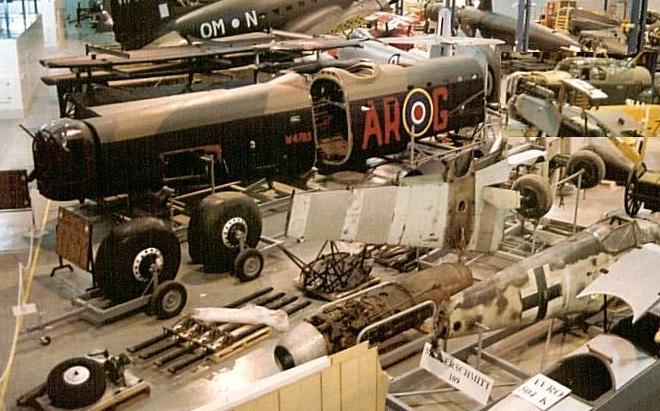 During the rejuvenation process, being carried out at the Treloar Centre, Canberra.
During the rejuvenation process, being carried out at the Treloar Centre, Canberra.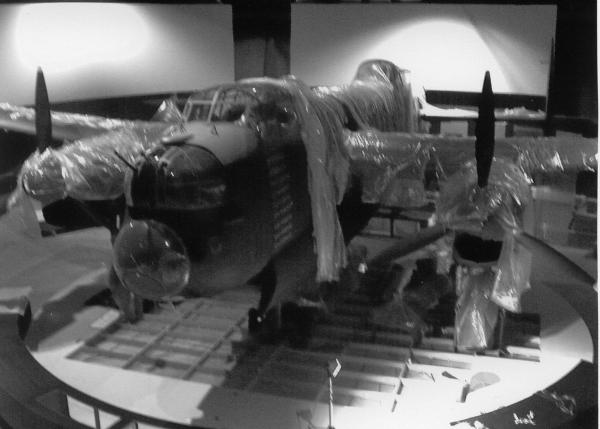 Mid–October 2003, Refurbished almost like brand new. Ready for another display at the Australian War Memorial.
Mid–October 2003, Refurbished almost like brand new. Ready for another display at the Australian War Memorial.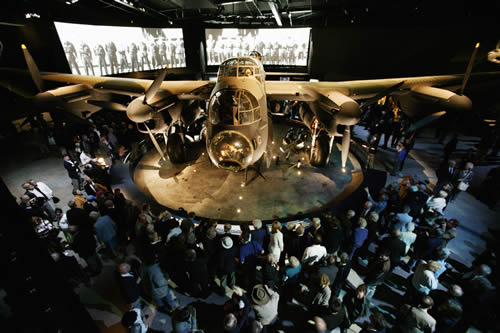 "G" for George in the "Striking by night" exhibit at the Australian War Memorial, Canberra.
"G" for George in the "Striking by night" exhibit at the Australian War Memorial, Canberra."G" for George completely refurbished, one of only two Lancasters left which actually flew on WWII raids over enemy occupied territory. Now featured in the spectacularly stunning new realistic presentation "Striking by night" depicting a night raid over Berlin December, 1943. A wonderful permanent presentation for all future patrons visiting the Australian War Memorial, Canberra, of what it was like raiding a WWII target. An excellent presentation which has openly seen Bomber Command veterans shed a tear as they stood and experienced a curtain lifting on their vividly remembered war time experiences.